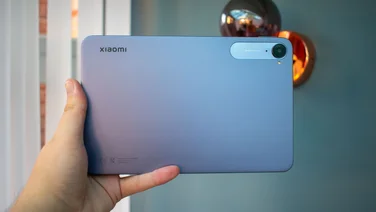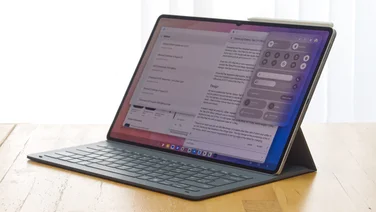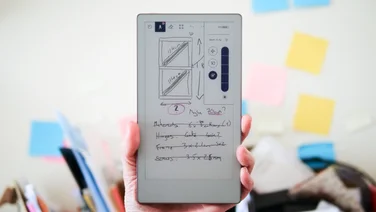To help us provide you with free impartial advice, we may earn a commission if you buy through links on our site. Learn more













- Excellent build quality
- Fast performance
- Ability to doodle in colour
- Extremely expensive
- Android adds unnecessary complexity
- Android Apps aren’t built for e-ink
If you think that paper-like notepads are fatally hampered by their monochrome e-ink screens, then Onyx has answered your prayers with the Boox Tab Ultra C.
Rather than denoting an inferior product (remember the iPhone 5c?), the ‘C’ here stands for colour, with the Boox Ultra C allowing you to create or consume content in glorious (well, quite muted) technicolour.
Not only that, but the product is a fully-fledged tablet, running Android 11 and capable of running apps downloaded from the Google Play Store. Surely that puts it head and shoulders above its opponents?
Well, yes and no. Read on to find out why it’s a thumbs-up, but not a nailed-on must-buy.
Onyx Boox Tab Ultra C: What do you get for the money?
The Onyx Boox Tab Ultra C is a 10.3in (225 x 184.5 x 6.7mm) tablet with an E Ink Kaleido 3 screen capable of displaying 4,096 colours. In black and white, it has a crisp 2,480 x 1,860 resolution (300ppi) which is halved to 1,240 x 930 for colour (still a very respectable 150ppi).













Unusually for an e-ink tablet, it runs Android 11 and its associated compatible apps, expandable via the Google Play Store. This means you can download apps, run a web browser, even watch Netflix if you like. It’s all possible, although, as we’re about to find out, not necessarily desirable.
You also get a big dent in your bank account. The Onyx Boox Tab Ultra C isn’t cheap, coming in at 650 euros, or around £558. Notably, that doesn’t include the keyboard cover case, which will set you back an additional 66 euros (or at around £55), although it does come with the all-important pen.













That’s buying it direct from Onyx – the Amazon store has the tablet listed at £600 and the keyboard case at £120, a price that puts it on the same level as the 2022 iPad (£499) with an Apple Pencil (£109). It’s far pricier than its closest rivals, too, with the Amazon Kindle Scribe — coming in at £330 and the ReMarkable 2, which remains our favourite digital note taker, £339.
Do you need the keyboard case? Not strictly speaking but it will keep the tablet protected and, crucially, typing on it is quite pleasant. It connects securely via pogo pins for a Surface-style experience, while the stylus attaches to one edge magnetically.
Onyx Boox Tab Ultra C: What do we like about it?
It’s hard to fault the design. The aluminium build and weightiness (it comes in at just over 450 grams) instantly make it feel like a premium product, even before you see the beauty of e-ink colours on screen.













Colour screens are, of course, nothing new. But e-ink colour screens are still rare, and the beauty of it here is that it deliberately misses the vibrancy that you get on smartphone and tablet screens. Here, reading a colour graphic novel is largely like reading one on a page and far easier on the eyes than on the equivalent LCD or OLED display. Yes, it’s slightly more washed out and there’s a visible element of ghosting for content with multiple pages/frames (more on that later) but it’s largely a win.
And if you want the ability to write and draw in colour with a paper-like feel, there really is no alternative. I’m not sure how many people that applies to, but if you’re in that niche then this could well be the e-paper notepad for you.













On the subject of writing, the experience is excellent. Like its rivals, the Boox Tab Ultra C lets you open up all kinds of paper templates (lined paper, graph paper, a blank sheet – you name it) and then just doodle away.
The bundled stylus pen is speedy, responsive and matches how hard you press with 4,096 levels of pressure. While it doesn’t exactly feel like writing on paper immediately, one of the quirks of using a pad like this for an extended period is that, after a while, it does replace your memory of analogue scribbling.













With a tap of the AI button in the sidebar, your text will be digitised with impressive accuracy, even with my lazy scrawl. Impressively, while it ships with just US English and Chinese language recognition, there are 63 more to download instantly with a single tap. Everything from Cebuano to Swahili is represented.













Sharing documents is also easy, with no cable required. Either log in on the Boox website or, if you’re on the same network, scan a QR code or type in a unique URL and you’ll be able to drag and drop files to and from your device with no login required.
Neatly, there’s also a 16MP rear camera on the back for scanning documents. My experience with this was mixed, with folded paper confusing it and sometimes making lettering appear misaligned in the saved copy but it’s objectively a good thing to be able to scan a document and sign it digitally with a handwritten signature.













The fact that this tablet runs Android 11 is, ultimately, a win, too. No, that’s not the latest version of Google’s operating system – we’re up to 13 now, with 14 rapidly coming into view – but it still makes the Boox Tab Ultra C more flexible than its rivals.
Download Twitter and tweet the night away if you like. Better still, sync your Google apps to other devices, upload your doodlings with Google Drive, Dropbox or whatever other Android app you choose. What’s not to like?













To make Android run convincingly, the Boox Tab Ultra C has by far the strongest specs we’ve seen in an e-ink tablet with a Qualcomm Snapdragon 662 processor backed with 4GB RAM and 128GB of expandable internal storage.
Those are mid-range specs in the world of phones and tablets but in this niche they’re unheard of, and it performs solidly as a result, although not noticeably better than its rivals.
Onyx Boox Tab Ultra C: What could it do better?
The big question is whether running Android is actually a good idea. Alas, I’m not convinced and that’s mostly due to the fact that most apps aren’t designed for low-refresh rate e-ink screens.
Yes, you can download YouTube and watch videos (with surprisingly good sound quality) but the ghosting and graininess makes it akin to watching a GameBoy cutscene. You can play games, too, and while it’s serviceable for slow-paced puzzle games anything else is unplayable.













In Onyx’s defence, it’s well aware of this, and the company makes it clear that you can tweak the settings on a per-app basis to make them play more nicely. You can adjust the DPI or the refresh rate, to make things move more smoothly at the expense of detail. But I found ghosting present on each setting in the Comixology app and it’s still a trade-off compared to using your common or garden Android tablet – even a comically bad one.
On (e-) paper, that flexibility is a good thing. If you want to download an app, then it’s nice to know that you can. But because the experience doesn’t tend to be great, I think there’s an argument to be made for the forced simplicity offered by the ReMarkable 2 or, to a lesser extent, the Kobo Elipsa 2E.













In fact, cards on the table time: I prefer a streamlined experience for a notepad-like device. Your mileage may vary. You doubtless get more value from a wannabe jack-of-all-trades like this but, for me, it’s a less delightful product as a result.
On the subject of its rivals, writing on the screen with the stylus did it feel a hair less responsive than the ReMarkable 2 when comparing the two side by side. In other words, it offers a superb writing experience – far better than the Kobo Elipsa 2E, which was noticeably laggy, and the awful Huawei MatePad Paper – but not quite the best we’ve tested. You could argue that the addition of colour more than makes up for this small discrepancy, however.
Onyx Boox Tab Ultra C: Should you buy it?
At around £558 (650 euros), the Onyx Boox Tab Ultra C is comfortably the most expensive in an already pricey field, and that’s before you factor in the optional keyboard cover which takes it to around £613 (716 euros).
The Amazon Kindle Scribe is nearly half the cost at £330, the ReMarkable 2 a similar price at £339 while the Kobo Elipsa 2E is £350 and the Huawei MatePad Paper is £420. Even Onyx’s own Boox Note Air 2 at 420 euros makes the Tab Ultra C look pricey, although that doesn’t have a colour display.
Personally, I wouldn’t stump up the extra, especially since the ReMarkable 2 delivers everything I’m looking for from a digital notepad. But, then I already have an iPad Mini for apps and media. If you don’t, and you’re looking for a device that can (kind of) do it all, but are mainly in the market for a great note-taker, then the Onyx Boox Tab Ultra C is worth considering.







